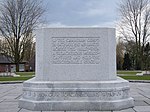Battle of Poelcappelle

The Battle of Poelcappelle was fought in Flanders, Belgium, on 9 October 1917 by the British Second Army and Fifth Army against the German 4th Army, during the First World War. The battle marked the end of the string of highly successful British attacks in late September and early October, during the Third Battle of Ypres. Only the supporting attack in the north achieved a substantial advance. On the main front, the German defences withstood the limited amount of artillery fire achieved by the British after the attack of 4 October. The ground along the main ridges had been severely damaged by shelling and rapidly deteriorated in the rains, which began again on 3 October, turning some areas back into swamps. Dreadful ground conditions had more effect on the British, who needed to move large amounts of artillery and ammunition to support the next attack. The battle was a defensive success for the 4th Army, although costly to both sides. The weather and ground conditions put severe strain on all the infantry involved and led to many wounded being stranded on the battlefield. Early, misleading information and delays in communication led Plumer and Haig to plan the attack of 12 October (the First Battle of Passchendaele) under the impression that a substantial advance had taken place at Passchendaele ridge when most of the captured ground had been lost to German counter-attacks.
Excerpt from the Wikipedia article Battle of Poelcappelle (License: CC BY-SA 3.0, Authors, Images).Battle of Poelcappelle
Bruggestraat,
Geographical coordinates (GPS) Address Nearby Places Show on map
Geographical coordinates (GPS)
| Latitude | Longitude |
|---|---|
| N 50.922 ° | E 2.963 ° |
Address
Bruggestraat 18
8920
West Flanders, Belgium
Open on Google Maps









